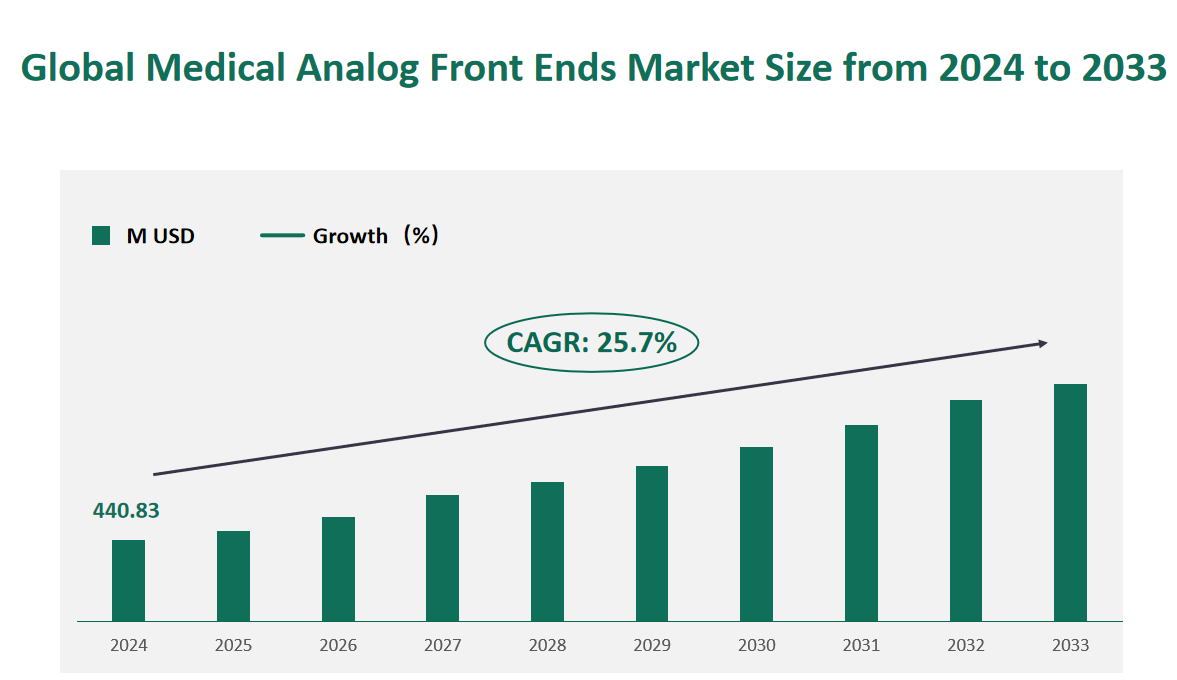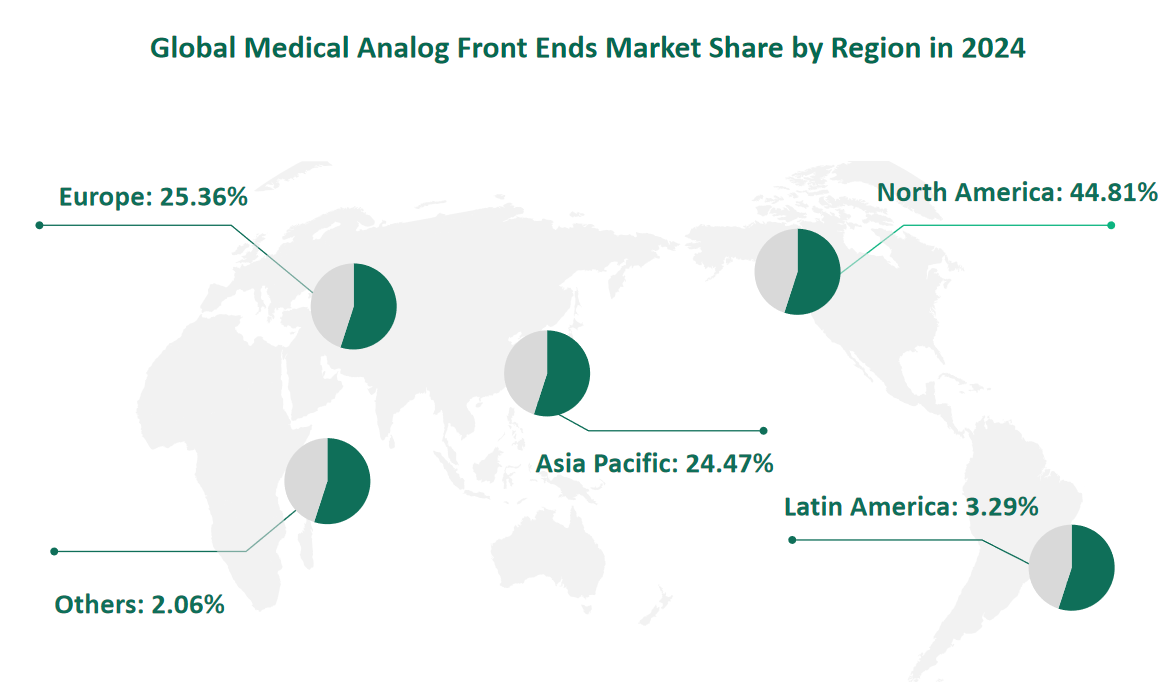1 Global Medical Analog Front Ends Market Size (Value) and CAGR (2024-2033)
In 2024, the global Medical Analog Front Ends market value is forecasted to reach $440.83 million, with a CAGR of 25.7% from 2024 to 2033.
A Medical Analog Front End, often referred to as an AFE, is a collection of analog signal conditioning circuitry that employs sensitive analog amplifiers, frequently operational amplifiers, filters, and sometimes application-specific integrated circuits for sensors, radio receivers, and other circuits. These components provide a flexible and programmable electronics functional block required to connect a variety of sensors to an antenna, an analog-to-digital converter, or in some cases, a microcontroller. In the medical field, AFEs are specifically designed for applications such as ultrasound imaging and vital sign sensing, including 4-channel, 16-channel, and 32-channel AFEs.
Figure Global Medical Analog Front Ends Market Size (M USD) and CAGR 2024-2033

2 Medical Analog Front Ends Market Opportunities and Drivers
The Medical Analog Front Ends market is poised for significant growth, driven by a confluence of factors that present substantial opportunities. The increasing demand for portable health and wellness products has been a key driver, as advancements in technology have led to a paradigm shift in healthcare treatment options. There is a growing need for wireless health-monitoring systems that utilize portable and wearable low-power devices for sensing biopotential signals. Innovations in sensors and semiconductor technologies have enabled the development of portable devices capable of capturing and recording biopotential signals outside of hospital settings.
The demand for portable health products has surged as individuals become more proactive in their healthcare, with smartphones and wearables incorporating health-centric sensors for early detection and real-time monitoring of health disorders. These devices can detect conditions like tachycardia, bradycardia, and arrhythmia, highlighting the importance of analog-to-digital converters (ADCs) and the subsequent need for AFEs, which amplify, filter, and prepare signals for digital interpretation.
Another opportunity arises from the increasing demand for high-performance portable ultrasound imaging systems, which require AFE solutions that meet strict size and power limits while delivering comparable performance to traditional systems. The evolution of semiconductor technology has been crucial in overcoming technical barriers, enabling the miniaturization and improvement of ultrasound systems.
The AFE market also benefits from the simplification of AFE designs, with a shift towards configurable AFEs that reduce development time and costs. These AFEs offer flexibility and scalability, supporting various sensors and adjusting in the field, which is essential for sensor trimming and accounting for sensor drift.
3 Medical Analog Front Ends Market Technology Cost Analysis
The cost analysis of Medical Analog Front Ends is a critical aspect of understanding the market’s financial landscape. Complementary metal-oxide semiconductor (CMOS) technology is prevalent in the implementation of AFEs due to its simple structure, low power consumption, large noise tolerance, strong temperature stability, and high integration capabilities. These attributes are essential for the performance and cost-effectiveness of medical devices.
The raw material costs, primarily associated with CMOS technology, constitute a significant portion of the total production cost. Strategic sourcing of raw materials is crucial for manufacturers to maintain a competitive edge. Global sourcing, localized procurement, and centralized purchasing can effectively reduce time and labor costs, which are also significant factors in the total production cost.
As technology advances, there is an expectation that more cost-effective and high-performance medical AFE products will emerge. Investment in research and development, as well as the adoption of advanced materials and production methods, will play a pivotal role in reducing costs and improving product performance.
4 Global Medical Analog Front Ends Market Size and Share by Type in 2024
The global Medical Analog Front Ends market is segmented into various types, each serving distinct applications within the medical sector.
4-Channel:
The 4-channel AFEs are designed to handle four independent input channels, each with a programmable input capacitance, a single-ended-input to differential-output Programmable Gain Amplifier (PGA), an offset DAC, an ADC, and a digital processor. These AFEs are compact and suitable for applications requiring simultaneous monitoring of four biopotential signals, such as in basic vital sign monitoring. The market scale for 4-channel AFEs in 2024 is projected to be $206.04 million, reflecting their importance in the medical AFE market.
16-Channel:
The 16-channel AFEs offer sixteen independent channels, each with similar functionalities as the 4-channel AFEs but on a larger scale. These are used in more complex applications where multiple biopotential signals need to be monitored simultaneously, such as in advanced patient monitoring systems or multi-parameter health tracking devices. The market scale for 16-channel AFEs in 2024 is forecasted to reach $67.57 million, indicating a growing demand for high-channel count AFEs in the medical industry.
32-Channel:
The 32-channel AFEs are the most extensive in this category, providing thirty-two independent channels with the same core functionalities. These AFEs are utilized in highly specialized medical equipment where a large number of biopotential signals need to be processed, such as in high-resolution brain activity mapping or comprehensive cardiac monitoring. The market scale for 32-channel AFEs in 2024 is expected to be $40.76 million, showcasing the niche but significant role of these AFEs in the medical sector.
Table Global Medical Analog Front Ends Market Size and Share by Type in 2024
Type | Market Size (M USD) 2024 | Market Share 2024 |
4-channel | 206.04 | 46.74% |
16-channel | 67.57 | 15.33% |
32-channel | 40.76 | 9.25% |
Others | 126.47 | 28.69% |
5 Global Medical Analog Front Ends Market Size and Share by Application in 2024
The Medical Analog Front Ends market is segmented into various industry applications, each with its unique market scale and growth trajectory.
Ultrasound Imaging:
Ultrasound imaging is a non-invasive medical technique that uses high-frequency sound waves to create images of the inside of the body. The AFEs used in this application are designed to process the analog signals from ultrasound transducers, converting them into digital signals for image reconstruction. The market scale for ultrasound imaging AFEs in 2024 is projected to be $115.23 million, highlighting the significant role of AFEs in advancing diagnostic imaging capabilities.
Vital Sign Sensing:
Vital sign sensing involves the measurement of essential bodily functions such as heart rate, blood pressure, and respiratory rate. AFEs in this application are critical for accurate data acquisition and processing of these vital signs. The market scale for vital sign sensing AFEs in 2024 is expected to reach $260.65 million, reflecting the growing importance of continuous health monitoring in personal and clinical settings.
Table Global Medical Analog Front Ends Market Size and Share by Application in 2024
Application | Market Size (M USD) 2024 | Market Share 2024 |
Ultrasound Imaging | 115.23 | 26.14% |
Vital Sign Sensing | 260.65 | 59.13% |
Others | 64.95 | 14.73% |
6 Global Medical Analog Front Ends Market Size and Share by Region in 2024
The global Medical Analog Front Ends market is distributed across various regions, each with its own market scale and development status.
North America:
North America, with its advanced healthcare infrastructure and high demand for sophisticated medical technology, leads the market. The region’s market scale in 2024 is projected to be $197.54 million, accounting for a significant share of the global AFE market. The presence of key industry players and a focus on innovation contribute to the region’s dominance.
Europe:
Europe follows with a market scale of $111.81 million in 2024. The region’s well-established healthcare systems and a strong emphasis on medical research and development drive the demand for advanced medical AFEs. Countries like Germany, the UK, and France are significant contributors to the region’s market scale.
Asia-Pacific:
The Asia-Pacific region is expected to have a market scale of $107.89 million in 2024. The rapid economic development and increasing healthcare expenditure in countries like China, Japan, and South Korea are fueling the growth of the AFE market in this region.
Latin America:
Latin America’s market scale in 2024 is forecasted to be $14.51 million. The region is experiencing growth due to improving healthcare services and increasing awareness about advanced medical technologies.
Others:
The ‘Others’ category, including the Middle East and Africa, is projected to have a market scale of $9.08 million in 2024. While these regions may have smaller market scales, they present opportunities for growth due to developing healthcare infrastructure and the need for advanced medical solutions.
Figure Global Medical Analog Front Ends Market Share by Region in 2024

7 Major Players in Global Medical Analog Front Ends Market
7.1 Analog Devices (Maxim Integrated)
Analog Devices, known for its data conversion, signal processing, and power management technology, is a multinational semiconductor company headquartered in Wilmington, Massachusetts. With a business overview that highlights its specialization in serving the automotive, industrial, healthcare, mobile consumer, and cloud data center markets, Analog Devices has a subsidiary, Maxim Integrated, that develops innovative analog ICs.
In 2022, Analog Devices (Maxim Integrated) reported a revenue of $119.57 million and a gross profit of $62.61 million, with a gross margin of 52.36%.
Their product introduction includes the ADPD4100, a multimode AFE that operates as a complete sensor front end, supporting various measurements and applications in wearable health and wellness monitors, industrial monitoring, and home patient monitoring.
7.2 Texas Instruments
Texas Instruments, a technology company based in Dallas, Texas, designs and manufactures semiconductors and integrated circuits for a global market. With a business overview that emphasizes its contribution to industrial, automotive, personal electronics, communications equipment, and enterprise systems, Texas Instruments has a strong foothold in the medical AFE market.
In 2022, Texas Instruments reported a revenue of $97.74 million and a gross profit of $55.72 million, with a gross margin of 57.00%.
Their product, the AFE4432, is an ultra-small, ultra-low-power, high-SNR integrated AFE designed for wearable optical biosensing, supporting up to 4 LEDs and 3 photodiodes, and is ideal for heart-rate monitoring and SpO2 measurement.
7.3 Ams AG
Ams AG, headquartered in Austria, is a global leader in optical solutions, offering a unique product and technology portfolio for sensing, illumination, and visualization. With a business overview that showcases its commitment to providing prime-quality light emitters, optical components, micro-modules, light sensors, ICs, and related software, Ams AG has a significant impact on the medical AFE market.
In 2022, Ams AG reported a revenue of $50.24 million and a gross profit of $25.71 million, with a gross margin of 51.17%.
Their product, the AS7057, is a biosignal sensor AFE that enables the detection of biosignals such as photoplethysmogram (PPG) and pulse transit time (PTT), as well as proximity, making it well-suited for in-ear vital sign monitoring and other space-limited applications.

